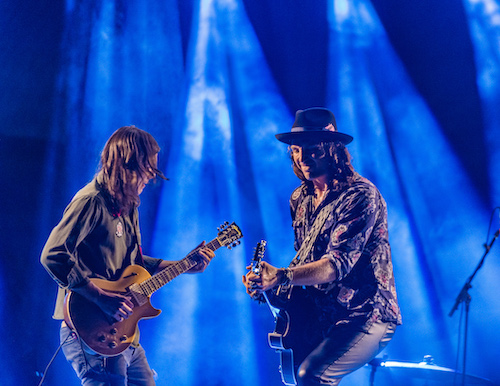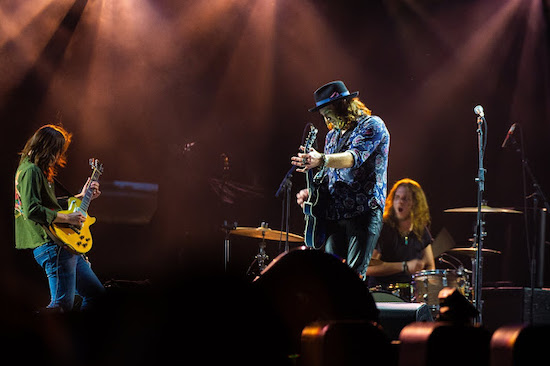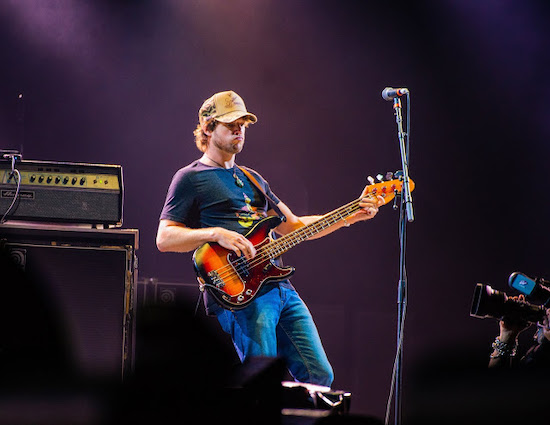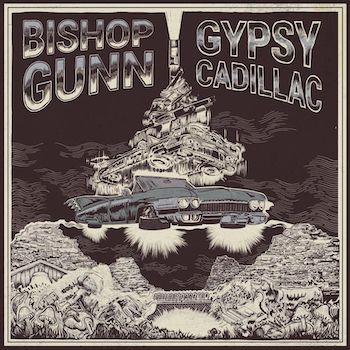
Photo: Bishop Gunn by Anthony Scarlati
By Tom Scarborough
The annals of Rock are littered with the wreckage of bands of immense promise that hit the self-destruct button too soon. Many of us—especially those of us who are Boomers—have seen the soaring trajectories and spectacular flameouts of many talented artists who flew too close to the sun—Tommy Bolin, Cream, and Nirvana come to mind. But few of us have ever seen a band of such enormous potential as Bishop Gunn take direct aim at the stars, only to then self-detonate on the launching pad one second before liftoff.
Hailing from the old river town of Natchez, Mississippi, Bishop Gunn spun heads with the force of their 2018 debut album, Natchez, and with the precocity of their ascent up the cursus honorum of rock n’ roll. The album showcased the band’s grounding in the deep blues of their home state, supercharged by lead singer Travis McCready’s once in a generation rock and soul-drenched vocals, and born frontman stage presence. Bishop Gunn dazzled audiences with their devastating performances, mauling more than a few headliners in the process.
The band may have broken up a year ago, but Bishop Gunn’s second and final album, Gypsy Cadillac, will finally smack us in the ears on July 9th, the sixth anniversary of the passing of McCready’s older brother, John. Recorded at the legendary Fame Studios, in Muscle Shoals, Alabama, with Grammy-winning producer, Casey Wasner, and three-time Grammy-winning producer, Jaquire King, on the console, the album is a fitting capstone to Bishop Gunn’s brief, but brilliant fly-by. Eighteen months after Bishop Gunn put the finishing touches on the album, Gypsy Cadillac is at last easing out onto the highway for its maiden run.
When the band went into Fame Studios in October 2019 to complete Gypsy Cadillac, expectations were that the band’s sophomore album would vault them into the national and international music consciousness. Everything that year seemed to point to the inevitability of the band’s epic success. Bishop Gunn got off to a hot start in February 2019, opening several dates for Slash on his European tour which included a triumphant end of tour show at Lisbon’s Campo Pequeno.

Photo: Drew Smithers, Travis McCready by Linda Gossett Stroud
The background murmur that had been building around the band became a certifiable industry buzz in July 2019, when Bishop Gunn opened for The Rolling Stones, at Houston’s NRG stadium. The band turned in a powerful performance that earned them the kind of ovation that bands opening for the Stones rarely receive. An October date in Omaha opening for Guns N’ Roses followed. By the end of 2019, it seemed all but certain that the band that had first played its hometown’s annual Balloon Festival only two years before, was on a carefully curated course heading straight toward the kind of commercial and critical stature few bands ever attain.
The dream ride veered into the wall in February 2020 when lead guitarist, Drew Smithers, announced his departure from the band. Within two weeks, the band posted an announcement on its website that it was suspending all future engagements and taking an indefinite break. Rumors of tensions within the band had circulated for months, and the speed of the meltdown seemed to confirm that Bishop Gunn had indeed cracked under the g-forces of its supersonic climb.
COVID 2020 would have scotched a tour in support of the release of Gypsy Cadillac, even if Bishop Gunn had not self-immolated. But with the unraveling of the band’s financial and promotional support apparatus, Gypsy Cadillac became an unreleased master work, heard only by a lucky few who received music files shared by band members. If Gypsy Cadillac seemed stillborn for the moment, the band’s legendarily loyal fan base–the Gunners–continued to clamor for its release.
Fortunately, a recent shift has occurred in the standoff between Bishop Gunn’s former management and the band that has finally led to the liberation of Gypsy Cadillac. Like an unwanted bastard child, the album is now being shoved out into the world with absolutely no publicity or support beyond whatever social media the former band members themselves generate. It is doubtful that so profound a rock album has ever been gestated with so little sustenance from those who created it. The album will only be available digitally (iTunes, Spotify), though at least one band member is raising funds to press a vinyl edition.
In October 2019, I sat down with Bishop Gunn lead singer, Travis McCready, at a noisy restaurant in Muscle Shoals, Alabama to discuss the album he and the band were then recording. I had spent the afternoon in the studio, watching the band working on the song, “Sadder Days.” Though the mood was professional and workmanlike, the vibe in the studio did not ooze camaraderie. Not until my interview with bassist, Ben Lewis, however, did I become fully aware of the tensions that simmered within the band during the recording of Gypsy Cadillac.
TRAVIS McCREADY—Lead Vocals (October 2019)
Tom Scarborough: Gypsy Cadillac seems to have a pretty defined thematic trajectory to it—it tells a story, of sorts. That wasn’t a characteristic of Bishop Gunn’s first album, Natchez. Did you guys set out to create a theme-oriented record?
Travis McCready: We didn’t really know at first what way or order we were going to put the songs in. We recorded 10 songs back in January (2019) with Casey (Wasner). The plan was to keep five and combine them with what we are doing during this session with Jaquire (King).
When we started with Jaquire, we kind of had a list—basically I could look down the list and see a story because I knew the content of each song. You could just look down and it takes you on a ride just looking down the page. So that’s the ride. Natchez was stationary. It consisted of songs that were written there. We weren’t really traveling or touring. But the past year we have done over 200 shows, from Europe to California. And we’ve opened for the Stones, and Guns N’ Roses. All we’ve done is ride. So, the concept for this record is all about movement.
Tom: How did you arrange the order of the songs to fit the concept of movement?

Photo: Burne Sharpe, Travis McCready by Linda Gossett Stroud
Travis: All these songs are in kind of an order. Gypsy Cadillac which talks about being a kid in a junkyard, you remember being a kid, no one sitting next to you and you’re just driving—pretending to drive. It’s imagination. Well that’s the same thing as when you get four guys in a fucking garage and pretend to be a fucking rock band. (Laughs) You’re basically pretending that this thing could fucking do anything. We were too stupid to know different until the fucking Cadillac started moving and then we were like, “Holy shit!”
Then the magic hits it and like, the bridge of the song goes “Put his foot on the gas /Headed nowhere fast / Down a dead-end street / Imagination for miles / Took him away for a while / He found the keys to his junkyard dream.” Basically, what the song is about is that everyone is born into a junkyard of information, foraging around for parts that eventually make up their character, personality, etcetera–ultimately building their vehicle in which they will travel through life down chosen highways. Build it yourself with integrity or you’ll be issued one, and you might not like how she handles.
Tom: And from there where does it go?
Travis: And then it goes through “What It Do” which lays out what happens when you find yourself in different scenarios and conundrums that you are trying to get out of. Then the next song, “Nothing To Lose” starts talking about, “Ain’t no need filling up that suitcase / Just throw in the things that you’re gonna use / We’ll be pulling out at daybreak / ‘Cause we ain’t got nothing to lose…the next verse goes on, “Take this time you have to call your mama / Help her understand what you gotta do / This old town will break you and it’s gonna / We ain’t got nothing to lose.” It’s a song about putting it all on the fucking line—we had to leave Natchez and risk everything.
The next song is “On My Way” which is basically about me leaving the metal shop and my dad saying to me, “make us proud.” He’s still in that shop today (John McCready Sr. passed away in August 2020). So, he has the currency of being proud of his son. I feel like my success has kind of fulfilled the hard work he has done. He sacrificed goals he had to raise six kids. The second verse says “Old man don’t you ever feel like you ain’t never been defined / From the sole of your worn out boots, the muddy footprints that you left behind / Old man can you see your son rise / A new dawn, same old blue eyes / Imagine rain comes falling down / They’re going to hear my thunder before your lightning hits the ground”
Tom: “Ain’t It A Shame” is pure soul, very evocative of one of your influences, Otis Redding. What’s it about?
Travis: Actually, I wrote it about myself from someone else’s perspective, “You give me sunshine / Then you pour down rain / Show me some good times / Then you cause me pain / The way I look at you / Will never be the same / Ain’t it a shame”
It’s like one of those “I don’t want to be another one of your sad songs.” Some of my better songs come from being honest with myself about things that don’t really sit well with me.
Tom: You guys do an amazing cover of “Mama Told Me Not To Come.” What inspired you to cover that one?
Travis: I used to cover it when I was a teenager in the bars. I love Three Dog Night. They were a real diverse band. They’d sing Muscle Shoals covers, Stax covers, Otis’s stuff. Hell, that song’s a cover from Eric Burdon, Randy Newman wrote it for him—Jaquire told me about that the other day.”
Tom: So how is this album going to be different from Natchez?

Photo: Bishop Gunn by Linda Gossett Stroud
Travis: Well, about this time last year we knew we were going in the studio soon. I was acoustic for the first couple of years of Bishop Gunn, and I started playing electric—I’d played electric in previous years back in the day, but I’d learned a bunch since then.
So, this time last year I got to thinking that the next album should have more guitar on it. What’s the most important element we could add? Well, maybe I should just get better on electric guitar and Drew and I could be double riffing, and I could basically be an addition. When we did the songs earlier this year in January, “What It Do” I’m doing all the wah-wah stuff, Drew’s doing the slide stuff, so it was already registering. And then we kind of looked and sounded more like a Southern rock band with dual matching guitars. I’m averaging eight to twelve or more hours a day with a guitar in my hand. I’ve played more guitar in the last nine months than I have in the previous ten years.
And then that started to change my writing. The songs we’re recording now, like “Black Train”—a lot of that stuff is written for me to accompany Drew, but we also riff, and trade off licks and stuff, like a Southern rock band. On “Sadder Days,” I’m just doing light runs and complements while Drew leads. So, the album will be different from Natchez because we are more of a guitar team. We’re just exploring the possibilities, it’s still trial run stuff.
Tom: Thanks for sharing your thoughts, Travis.
BEN LEWIS—Bassist (June 2021)
Tom: What’s your take on Gypsy Cadillac, and how would you compare it to Natchez?
Ben: Gypsy Cadillac is much darker than Natchez in my opinion, but I think it’s a reflection of the environment we were in at the time. Art is often a byproduct of the setting in which it was created.
Tom: So, what is the overarching theme of Gypsy Cadillac as an album?
Ben: Maybe Gypsy Cadillac is just the story of a child with an overactive imagination. The kid in the song is playing in a junkyard, a place of broken, lifeless things. But his imagination turns a junked car into a flying Cadillac. He essentially uses his imagination to escape how bleak his reality truly is.
Or it could be the story of an alcoholic’s first drink, or a junkie’s first high. Maybe it’s a glimpse at that first step in their downward spiral. Those people weren’t always trying to escape reality. They weren’t always abusive, narcissistic or manipulative. They weren’t always crying out., “Look at me now!” Those people weren’t always the way we see them today. At some point they were a little child with a big imagination. Hell, we all were.
Tom: It almost sounds like it could be a metaphor for Bishop Gunn? The tensions within the band at the time you were recording Gypsy Cadillac were causing the whole thing to shake and shimmy, and finally go into the ditch.
As I listened to the album, it had an undeniably sad vibe to it—almost a farewell aura to it. You guys sounded like a band that was worn out after twenty years together, yet you had only been together since 2017.
Ben: For me, the album feels like listening to previously unreleased music from an artist who has passed away. Maybe it’s because for the past year I’ve been grieving that loss and have only recently arrived at the acceptance stage.
Tom: What does it feel like to have Gypsy Cadillac finally emerge? Are you proud of the record?
Ben: The release is bittersweet in a lot of ways. Listening back on it now, there are some great moments that remind me of a time when we were all working together as a team. Most of those moments were in the songs we recorded in February 2019.
Tom: What changed?

Photo: Ben Lewis, bassist by Linda Gossett Stroud
Ben: By the time we returned to Muscle Shoals in October of that same year, everything had changed, We were so broken and so detached from one another. The tension between members of the band was a tangible thing at that point, and I think that comes out in the music. There’s an uneasiness to some of the songs. It was almost like there was a hellhound on our trail and we all knew it was there.
Tom: What do you love most about Gypsy Cadillac?
Ben: What most impresses me about this album is the musicianship, individually and collectively. Each individual band member made huge sacrifices and contributions in order to create this album. Despite how detached we were from one another towards the end, each member brought their best work to the table. We put our differences aside for the moment, and we served the song.
Tom: Any final thoughts?
Ben: This album is for the Gunners.
Tom: Thanks so much, Ben.
Bishop Gunn
Ben Lewis—Bass, vocals
Travis McCready—Lead vocals, guitar
Burne Sharp—Drums
Drew Smithers—Lead guitar

Gypsy Cadillac is available for download on July 9th on Spotify and iTunes.

Thank you for this insight. Can’t wait for the new music.
Just downloaded!!! Going to spend all weekend listening to it on the lake. So happy to have another one!!!
Love Bishop Gunn!!!
Reading this now while listening to this album and fighting back tears. The death of Bishop Gunn truly felt like a death in my family and I’m still not over it, don’t know if I ever will be. Thankful for this album release.
Ditto Robin. Just read this article while listening to the new album, and sad to think this beautiful record is their final work. I would love to think that they will reunite and continue to create their soulful bluesy southern rock.
Thanks, Tom! Always love your writings. Can not wait to download Gypsy Cadillac! Proud Gunner.
Ima gunner for sure…thanks….bittersweet indeed
I’m a gunner for life. So sad that it had to end like this. But the music remains
Love these young Gunns!!!! Saw them at Jones Beach and The Paramount in NY. Have all their music now
The Bishop Gunn demise is Soooo Sad, Such awesome musicians, writers and That voice!
I first heard about them via a couple of Robben Ford tracks on Purple House and just had to find out more, so went and bought the debut E.P and Natchez. Both blew me away, as has Gypsy Cadillac. While it’s a rock n roll tragedy they are no more, At least we have a couple of mighty albums for a legacy. I look forward to seeing where they all head to musically. But for now I’m forever a Gunner from Down Under. Thanks for the music boys.
Hey Tom, that was a great writeup with a lot of insight to the band and the album. It verifies a lot of what I saw and it told me a lot I didn’t know. Thanks my friend.
Keeping my fingers crossed that these guys will bury whatever it is that caused the demise of such a promising band. I feel extremely lucky to have seen them once, opening up for Marcus King Band at the Belly Up in Solano Beach. Great show!
My eldest son introduced me to Bishop Gunn. Unfortunately, it was after their parting of ways, or I’d be buying concert tickets for sure. Such a complete tragedy to lose future collaborations, as their music transcends genre, generations and delivers gritty, soulful magic!!